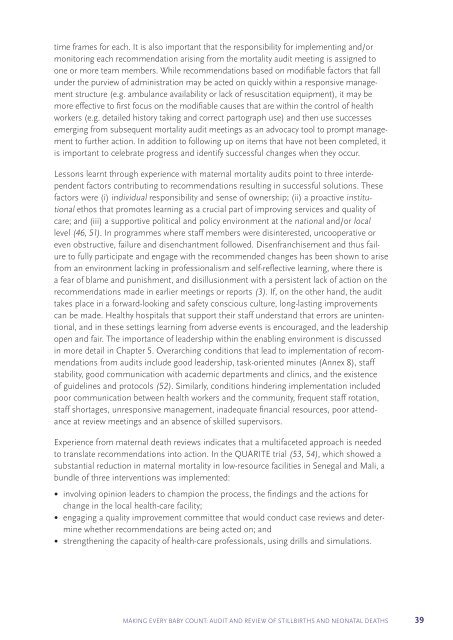Making Every Baby Count
9789241511223-eng
9789241511223-eng
Create successful ePaper yourself
Turn your PDF publications into a flip-book with our unique Google optimized e-Paper software.
time frames for each. It is also important that the responsibility for implementing and/or<br />
monitoring each recommendation arising from the mortality audit meeting is assigned to<br />
one or more team members. While recommendations based on modifiable factors that fall<br />
under the purview of administration may be acted on quickly within a responsive management<br />
structure (e.g. ambulance availability or lack of resuscitation equipment), it may be<br />
more effective to first focus on the modifiable causes that are within the control of health<br />
workers (e.g. detailed history taking and correct partograph use) and then use successes<br />
emerging from subsequent mortality audit meetings as an advocacy tool to prompt management<br />
to further action. In addition to following up on items that have not been completed, it<br />
is important to celebrate progress and identify successful changes when they occur.<br />
Lessons learnt through experience with maternal mortality audits point to three interdependent<br />
factors contributing to recommendations resulting in successful solutions. These<br />
factors were (i) individual responsibility and sense of ownership; (ii) a proactive institutional<br />
ethos that promotes learning as a crucial part of improving services and quality of<br />
care; and (iii) a supportive political and policy environment at the national and/or local<br />
level (46, 51). In programmes where staff members were disinterested, uncooperative or<br />
even obstructive, failure and disenchantment followed. Disenfranchisement and thus failure<br />
to fully participate and engage with the recommended changes has been shown to arise<br />
from an environment lacking in professionalism and self-reflective learning, where there is<br />
a fear of blame and punishment, and disillusionment with a persistent lack of action on the<br />
recommendations made in earlier meetings or reports (3). If, on the other hand, the audit<br />
takes place in a forward-looking and safety conscious culture, long-lasting improvements<br />
can be made. Healthy hospitals that support their staff understand that errors are unintentional,<br />
and in these settings learning from adverse events is encouraged, and the leadership<br />
open and fair. The importance of leadership within the enabling environment is discussed<br />
in more detail in Chapter 5. Overarching conditions that lead to implementation of recommendations<br />
from audits include good leadership, task-oriented minutes (Annex 8), staff<br />
stability, good communication with academic departments and clinics, and the existence<br />
of guidelines and protocols (52). Similarly, conditions hindering implementation included<br />
poor communication between health workers and the community, frequent staff rotation,<br />
staff shortages, unresponsive management, inadequate financial resources, poor attendance<br />
at review meetings and an absence of skilled supervisors.<br />
Experience from maternal death reviews indicates that a multifaceted approach is needed<br />
to translate recommendations into action. In the QUARITE trial (53, 54), which showed a<br />
substantial reduction in maternal mortality in low-resource facilities in Senegal and Mali, a<br />
bundle of three interventions was implemented:<br />
• involving opinion leaders to champion the process, the findings and the actions for<br />
change in the local health-care facility;<br />
• engaging a quality improvement committee that would conduct case reviews and determine<br />
whether recommendations are being acted on; and<br />
• strengthening the capacity of health-care professionals, using drills and simulations.<br />
MAKING EVERY BABY COUNT: AUDIT AND REVIEW OF STILLBIRTHS AND NEONATAL DEATHS<br />
39
















